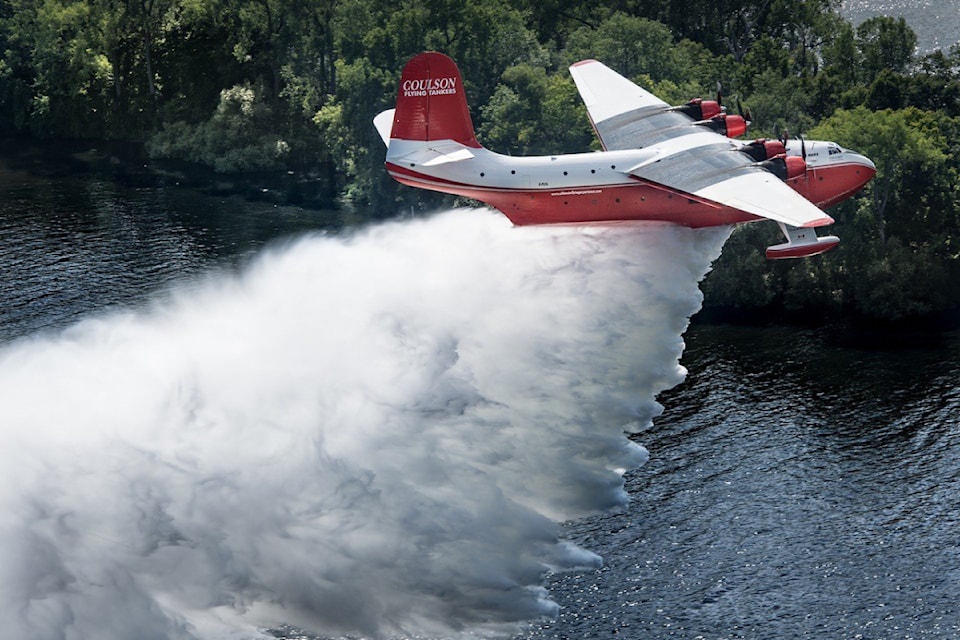Anyone arriving at Victoria International Airport can soon expect to be greeted by an iconic red and white Martin Mars water bomber from the runway.
For decades, the Hawaii Mars, a Martin JRM-3 Mars, protected forests and homes in the province. Retired by Coulson Aviation in 2015, the mothballed water bomber returned to its former longtime home in Sproat Lake near Port Alberni earlier this month as a team prepares to get it airworthy for that final flight to North Saanich.
It’s the latest move in the two-year Save the Mars campaign piloted by BC Aviation Museum board member Richard Mosdell.
The board immediately backed the plan he pitched to purchase the Hawaii Mars sitting idle and up for sale in Port Alberni.
“We’re obviously aviation enthusiasts out here,” museum president Steve Nichol told the Peninsula News Review. “We preserve and protect and promote the aviation history of British Columbia.”
A contract with Coulson and $250,000 provincial tourism grant in-hand, the team embarked on planning to get the Martin Mars water bomber on its final flight, followed by a trip over land, to the North Saanich museum near Victoria International Airport.
“The only way to get it here is to fly it down. It’s too big,” Nichol said.
Coulson announced the donation of its 1940s Second World-era converted water bomber to the museum in spring 2023. Once all maintenance, inspections and government approvals are complete, it’s expected to take its final flight in the first half of August.
“Our Mars maintenance and flight crews have been working diligently to prepare the aircraft for its final flight,” Coulson Aviation president and COO Britt Coulson said in a June news release. “Various factors continue to impact the schedule, making it difficult to establish a precise completion and delivery date. However, we are pleased to announce that we have surpassed its original expected fall arrival date.”
Once it arrives in Patricia Bay, on the Saanich Inlet, Hawaii Mars will be de-watered and carefully transported across Victoria airport land by Nickel Brothers, a company known for its house moves in Greater Victoria.
“They’ve moved three aircraft for us already in the last year and they are amazing professionals,” Nichol said. “This is the most complex maneuver you can imagine, we’re going to beach it onto a very narrow seaplane ramp at the Canadian Coast Guard there beside the Institute of Ocean Sciences.”
The move requires clearing a path, pulling out things such as lamp stands and power lines. With a “very supportive” Victoria Airport Authority, the plane will cross at West Saanich road into the back gate at the airport to get to the aviation museum, where an outdoor concrete pad awaits its celebrity resident.
“We’ll need a little WD40 here and there but we’ll get it done,” Nichol said.
The ultimate goal is to build Hawaii Mars a hangar. That sparked consideration of a new wildfire fighting museum – something that doesn’t yet exist, Nichol said.
“We already have two fire bombers here and we have two more people are willing to give us,” he said, adding tourism organizations are already voicing support for such a future endeavour. “Victoria hasn’t had a new tourist site for more than 20 years.”
Once Hawaii Mars is settled at the BC Aviation Museum in its existing BC Wildfire Aviation Exhibit, the museum plans to offer an open format that allows visitors to experience the Hawaii Mars up close and personal, including the opportunity to sit in the four-storey cockpit.
But this summer, the work remains to fund and move the Mars. The transition is a pricey one – the museum anticipates spending $800,000 even with Coulson covering many costs – with work and input from a dozen different agencies and municipalities.
“I think everyone recognizes the historic nature of this event. So it’s been very gratifying,” Nichol said. “It’s an iconic aircraft for British Columbia. For decades when there were these big fires people would hear the Mars coming and they’d go ‘we’re safe’ people tell us that.
“That’s why our motto is ‘the Mars saved B.C. now it’s time for B.C. to save the Mars’ and people are resonating on that.”
Hawaii Mars is one of two remaining Martin JRM-3 Mars water bombers. It flew cargo between Hawaii and the Pacific Islands during the Second World War and supported the Korean War with medical transport between Hawaii and California before transitioning to cargo operations. They were sold to a consortium of B.C. timber companies in 1958 and converted into the world’s largest water bombers to fight forest fires, carrying 27,000 litres per drop.
Coulson bought them in 2007, marking the start of its fixed-wing air tanker operations for aerial wildfire support. Coulson retired its Mars water bombers in 2015. The Philippine Mars, is heading to the Pima Air and Space Museum in Tucson, Arizona.
An official arrival and transport time is yet to be determined, but expected to be the first half of August.



